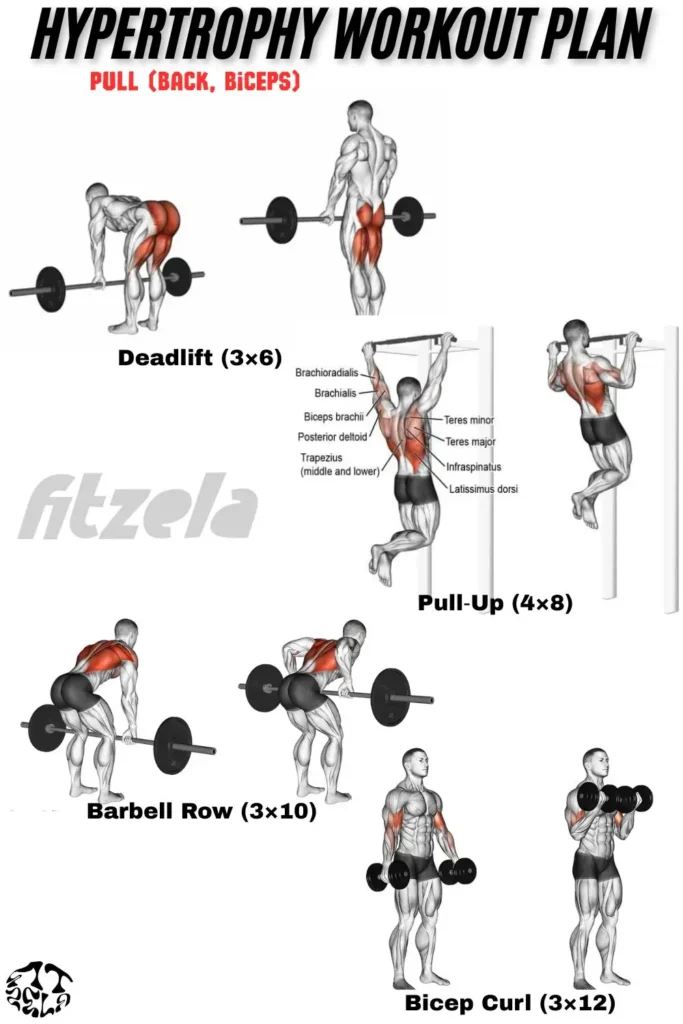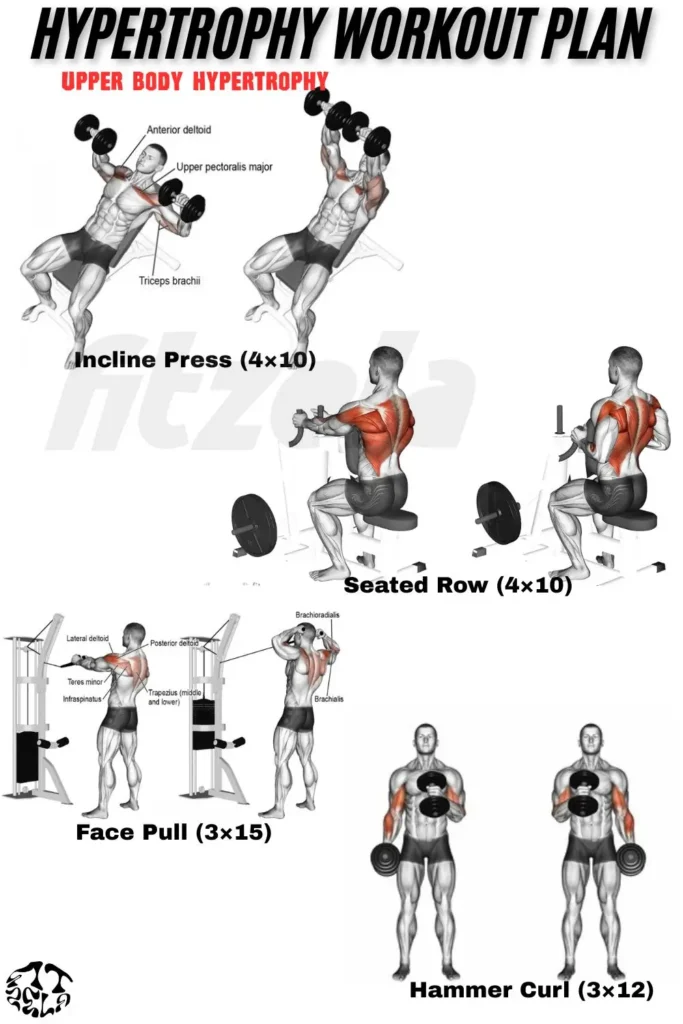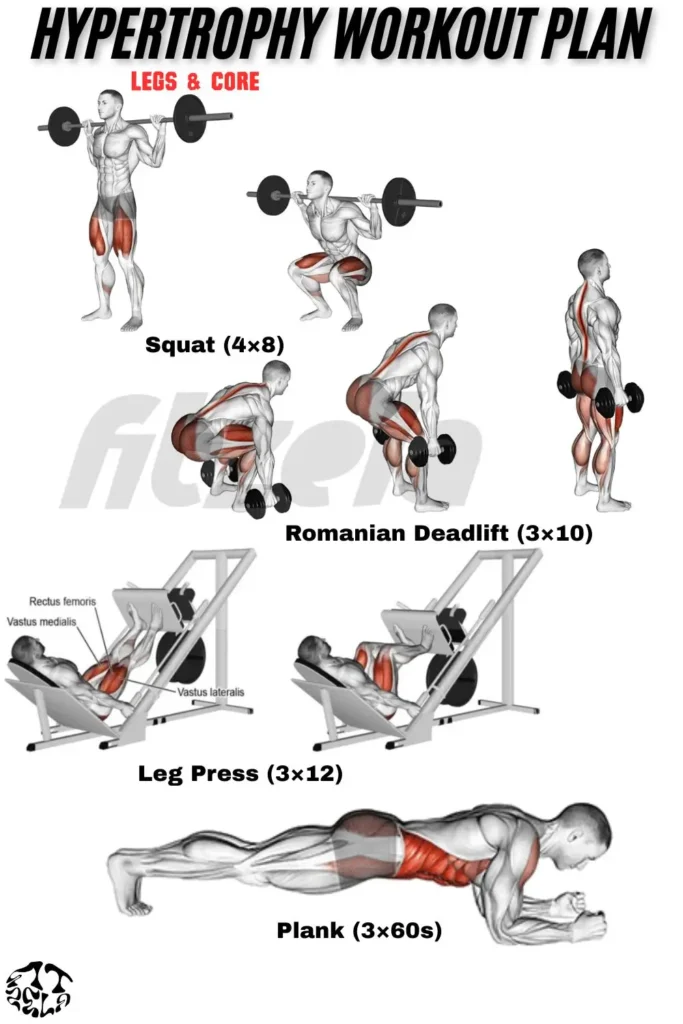Key principles of an effective hypertrophy workout plan for muscle growth.
Building muscle effectively requires more than just lifting heavy weights—it demands a well-structured hypertrophy workout plan that balances volume, intensity, and recovery. Whether you’re a beginner seeking visible gains or an advanced lifter chasing that next level of muscle growth, understanding the science behind hypertrophy is crucial. In this comprehensive guide, we’ll break down the key principles of an effective hypertrophy workout plan and offer actionable tips so you can start packing on lean muscle mass right away.
Table of Contents
1. What Is Muscle Hypertrophy?

Muscle hypertrophy refers to the increase in muscle fiber size, primarily through:
- Myofibrillar hypertrophy: Growth of the contractile elements (actin and myosin) for strength gains.
- Sarcoplasmic hypertrophy: Expansion of the fluid (sarcoplasm) around muscle fibers, improving muscle size and endurance.
A targeted hypertrophy workout plan combines both to maximize muscle growth and aesthetic development.
2. Core Principles of an Effective Hypertrophy Workout Plan
To optimize muscle gain, any hypertrophy workout plan should revolve around these fundamental principles:
- Progressive Overload
Gradually increase resistance, volume, or complexity to continually challenge muscles and stimulate growth. - Training Volume
Aim for 10–20 total sets per muscle group per week, depending on experience level and recovery ability. - Training Frequency
Hit each muscle group 2–3 times per week to maintain protein synthesis and consistent hypertrophic stimulus. - Intensity (Load & RPE)
Use weights that correspond to 65–85% of your one-rep max (1RM), typically in the 6–12 rep range, with an RPE (Rate of Perceived Exertion) of 7–9. - Exercise Selection
Combine compound movements (e.g., squat, bench press, deadlift) and isolation exercises (e.g., bicep curl, leg extension) for balanced development. - Rest & Recovery
- Intra-workout rest: 60–120 seconds between sets
- Post-workout recovery: 48–72 hours before targeting the same muscle group again
“Consistent overload plus sufficient recovery is the heartbeat of any hypertrophy program.” – Dr. Jane Warren, Exercise Scientist
3. Structuring Your Weekly Hypertrophy Workout Plan
Below is a sample 4‑day split that balances volume and recovery. Adjust exercises, sets, and reps according to your personal goals and experience.



| Day | Focus | Exercises (Sets × Reps) |
|---|---|---|
| Day 1 | Push (Chest, Shoulders, Triceps) | Bench Press (4×8), Overhead Press (3×10), Tricep Dip (3×12), Lateral Raise (3×15) |
| Day 2 | Pull (Back, Biceps) | Deadlift (3×6), Pull‑Up (4×8), Barbell Row (3×10), Bicep Curl (3×12) |
| Day 3 | Rest or Active Recovery | Light cardio, mobility drills, foam rolling |
| Day 4 | Legs & Core | Squat (4×8), Romanian Deadlift (3×10), Leg Press (3×12), Plank (3×60s) |
| Day 5 | Upper Body Hypertrophy | Incline Press (4×10), Seated Row (4×10), Face Pull (3×15), Hammer Curl (3×12) |
| Days 6–7 | Rest & Mobility | Yoga, stretching, light swim |



Pro Tip: Use a training log or app to track loads, sets, and reps. Data-driven tracking can reveal patterns in performance plateaus and help you adjust the plan accordingly.
4. Nutrition & Recovery: Your Growth Catalysts
No hypertrophy workout plan can succeed without proper fueling and rest. Follow these guidelines:
- Protein Intake: 1.6–2.2 g per kg body weight daily
- Caloric Surplus: +250–500 kcal above maintenance for steady lean gain
- Carbohydrates & Fats: Prioritize complex carbs around workouts; include healthy fats (1 g/kg) for hormone balance
- Sleep: Aim for 7–9 hours nightly to optimize muscle repair
Quick Checklist:
- Pre‑workout meal: 30–60 g carbs + 20–30 g protein
- Post‑workout meal: ≥0.3 g/kg protein + 1 g/kg carbs within 60 minutes
- Stay hydrated: at least 3 L water per day
5. Tracking Progress & Adjusting Your Plan
Regularly assess your results to ensure continual growth:
- Monthly Measurements: Track circumferences (arms, chest, thighs).
- Strength Benchmarks: Record PRs on key lifts.
- Visual Logs: Progress photos every 4–6 weeks.
- Auto‑Regulation: Adjust sets/reps based on energy levels (use RPE scale).
If gains stall for more than 3–4 weeks, consider:
- Increasing volume by 10–20%
- Incorporating advanced techniques (drop sets, supersets, rest‑pause)
- Adding deload week after 6–8 weeks of consistent training
6. Sample 8‑Week Hypertrophy Workout Plan
Use this template to kickstart your journey. Customize as needed:
| Week | Volume (Sets/Muscle) | Notes |
|---|---|---|
| 1–2 | Moderate (12 sets) | Focus on form mastery |
| 3–4 | Increased (15 sets) | Add 1–2 sets per muscle group |
| 5–6 | Peak Volume (18 sets) | Introduce supersets on isolation movements |
| 7 | Deload | 50% volume; maintain load with lighter effort |
| 8 | Restart Cycle | Reset to Week 1 load + 5% more weight |
7. Common Mistakes to Avoid
- Neglecting Warm‑Ups: Always prime muscles and joints.
- Overtraining: More isn’t always better—respect recovery windows.
- Poor Exercise Technique: Sacrificing form for load risks injury and limits results.
- Ignoring Accessory Work: Rotator cuff, hip stabilizers, and core are vital for long‑term progress.
- Inconsistent Nutrition: Gains happen in the kitchen as much as in the gym.
8. Personalizing Your Plan
Different readers have different needs. Here’s how to tailor the framework:
| Experience Level | Volume & Frequency | Intensity (Reps) |
|---|---|---|
| Beginner | 8–10 sets/muscle per week; 2× frequency | 8–12 reps @ 60–70% 1RM |
| Intermediate | 12–16 sets/muscle per week; 2–3× freq | 6–10 reps @ 70–80% 1RM |
| Advanced | 16–20+ sets/muscle per week; 3× freq | 4–8 reps @ 80–85% 1RM |
Data Insight: Research shows lifters in the intermediate stage achieve optimal hypertrophy around 15 sets per muscle group per week .

Conclusion & Next Steps
Implementing an effective hypertrophy workout plan is a blend of science, consistency, and personalization. By adhering to progressive overload, balancing volume and recovery, and fine‑tuning nutrition, you’ll set the stage for sustained muscle growth.








